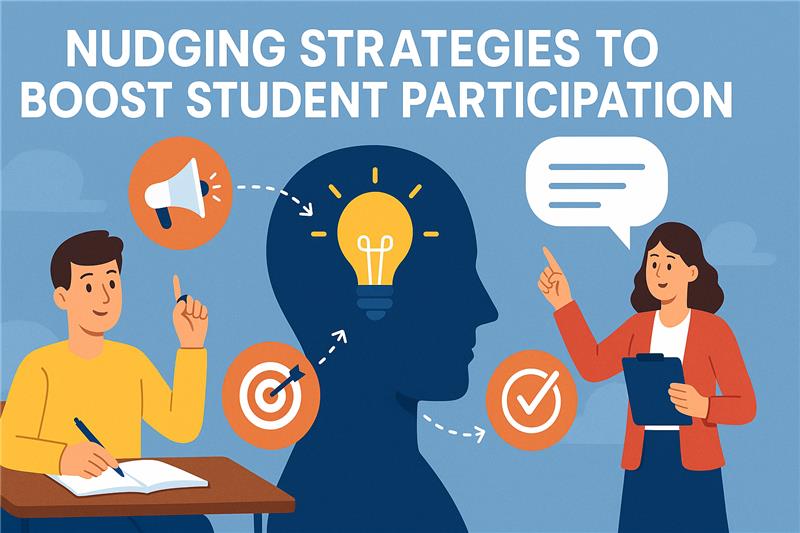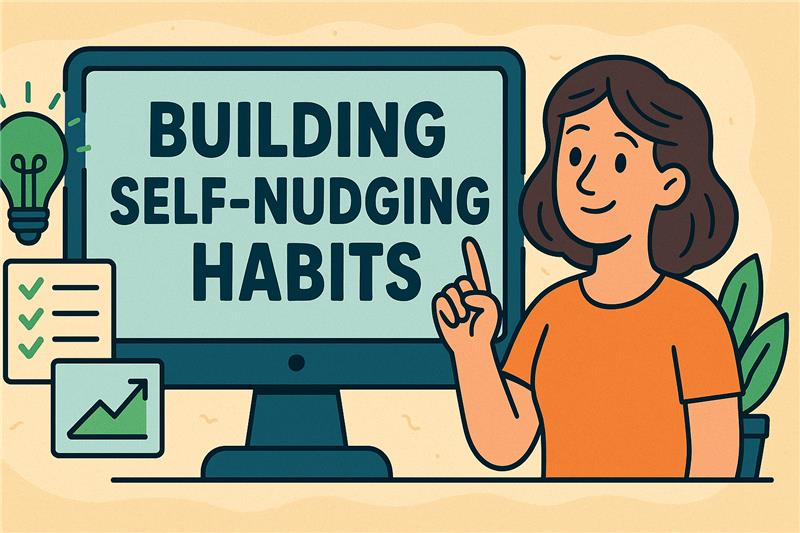
Building engagement doesn’t require a full tech overhaul. Often, it’s about introducing small, purposeful nudges that prompt students to act, without pressure. In this unit, we explore how educators can embed subtle, behaviourally informed strategies that activate students at just the right moment.
Nudging is not about manipulation or flashy add-ons. It’s about guiding attention and lowering the activation threshold for action. When nudging works, students feel like participation is easy, expected, and rewarding, without needing to be asked twice.
If Unit 1 explored why engagement matters, Unit 2 focuses on how to achieve it. Digital participation rarely happens by chance; it must be invited, scaffolded, and reinforced. Nudging offers a set of design strategies that make participation both easier and more rewarding, for students and educators alike.
The goal is not to turn every lesson into a game or to overwhelm learners with constant activity. Rather, it is to embed timely, low barrier prompts that help students cross the threshold from passive presence to active contribution. These prompts should feel natural, ethical, and consistent with the overall learning design.
Nudging strategies can be grouped into three principles that are particularly relevant for digital engagement:
Together, these principles create conditions in which engagement feels both expected and safe.
The Cheer-O-Meter is a live participation tracker that rises as students interact. Each contribution—whether an emoji reaction, chat post, or poll response—“fills” the meter. It can be represented visually as a thermometer, a progress bar, or even a set of emojis that light up on a slide.
This strategy works because it makes invisible contributions visible. Students see that their small actions matter, and educators gain a quick sense of group energy.
Example:
Self-Nudge for Educators: Place a reminder in your slide deck to check the Cheer-O-Meter every 10 minutes. This creates a habit of pausing to invite input.
Lecture Quest frames a session as a short journey with checkpoints. Instead of passively moving through slides, students “progress” by completing small tasks, such as answering a poll, solving a problem, or contributing to a Jamboard.
Example:
This approach turns engagement into collective progress rather than individual performance. It also creates natural breaks in delivery, reducing cognitive fatigue.
The first interaction sets the tone for the rest of the session. By inviting action within the opening minutes, educators communicate that participation is not optional, it is the norm.
Examples:
Self-Nudge: Add a sticky note to your desk or a recurring calendar reminder: “First interaction by minute three.”
Short reflective prompts invite students to pause and connect content to their own thinking. These can be collected anonymously or shared in small groups.
Examples:
Matching Challenges with Strategies
Challenge | Nudge Strategy | Why It Works |
Early silence in class | First-Click Nudge | Sets expectation of immediate participation |
Mid-lecture fatigue | Lecture Quest checkpoint | Provides natural reset and renewed attention |
Invisible contributions | Cheer-O-Meter | Makes micro-actions visible and collective |
Low motivation | Micro-Reflection prompts | Links learning to relevance and personal meaning |
While nudges encourage participation, they must be applied ethically. This means:
Ethical nudging builds trust, which is essential for sustained engagement.

Educators benefit from nudging themselves as much as students. Consider the following self-nudges:
These micro-habits reduce decision fatigue and help make interactive teaching the default mode.
Watch the following video to see how Temasek Polytechnic turned a common challenge into an opportunity by using Brightspace Intelligent Agents to send personalised, behaviourally informed nudges that boosted engagement, supported timely task completion, and fostered joy and self-regulation in learning—ideal for educators and instructional designers seeking to enhance student motivation with technology.
For your next class, choose one of these experiments:
Afterward, reflect: Did participation increase? Which students engaged who usually stay silent? What might you adjust for next time?
Gamification refers to the use of playful elements, such as points, levels, or quests, to motivate participation. In the context of Nudging 360°, gamification is not about competition or rewards, but about making engagement visible and enjoyable. Strategies like the Cheer-O-Meter or Lecture Quest apply light gamification by framing participation as collective progress. These mechanics encourage small actions without pressuring students, reinforcing both motivation and a sense of shared journey.
Example:
Imagine you are teaching a 45-minute online seminar on critical thinking. Instead of delivering a continuous lecture, you introduce a “Critical Thinking Quest” with three checkpoints:
(1) Checkpoint 1 – Spot the Fallacy
In the first 10 minutes, you present two short arguments. Students vote in a poll to identify the logical fallacy. When 70% answer, the first checkpoint is “unlocked.”
(2) Checkpoint 2 – Quick Chat Challenge
At minute 20, you ask students to post one sentence in the chat beginning with “A good critical thinker always…” Each contribution adds to a shared word cloud. When the cloud reaches a set number of entries, the second checkpoint is achieved.
(3) Checkpoint 3 – Group Puzzle
In the last 10 minutes, breakout groups receive a short case study. They must suggest one critical question to test the argument. Each group posts its question on Padlet, completing the quest.
At the end of class, you briefly review the three checkpoints, showing how the group advanced together.
In this unit, you explored practical nudging strategies that make engagement visible, timely, and safe. You saw how the Cheer-O-Meter, Lecture Quest, and First-Click Nudges provide low-effort but high-impact ways to encourage participation. You also reflected on the importance of building your own self-nudging habits as an educator.
In Unit 3, we shift from individual strategies to lesson design as a whole. You will learn how to structure your sessions so that nudges are not isolated tactics but integrated parts of your teaching rhythm. This structural approach ensures that active learning becomes the default, not the exception.